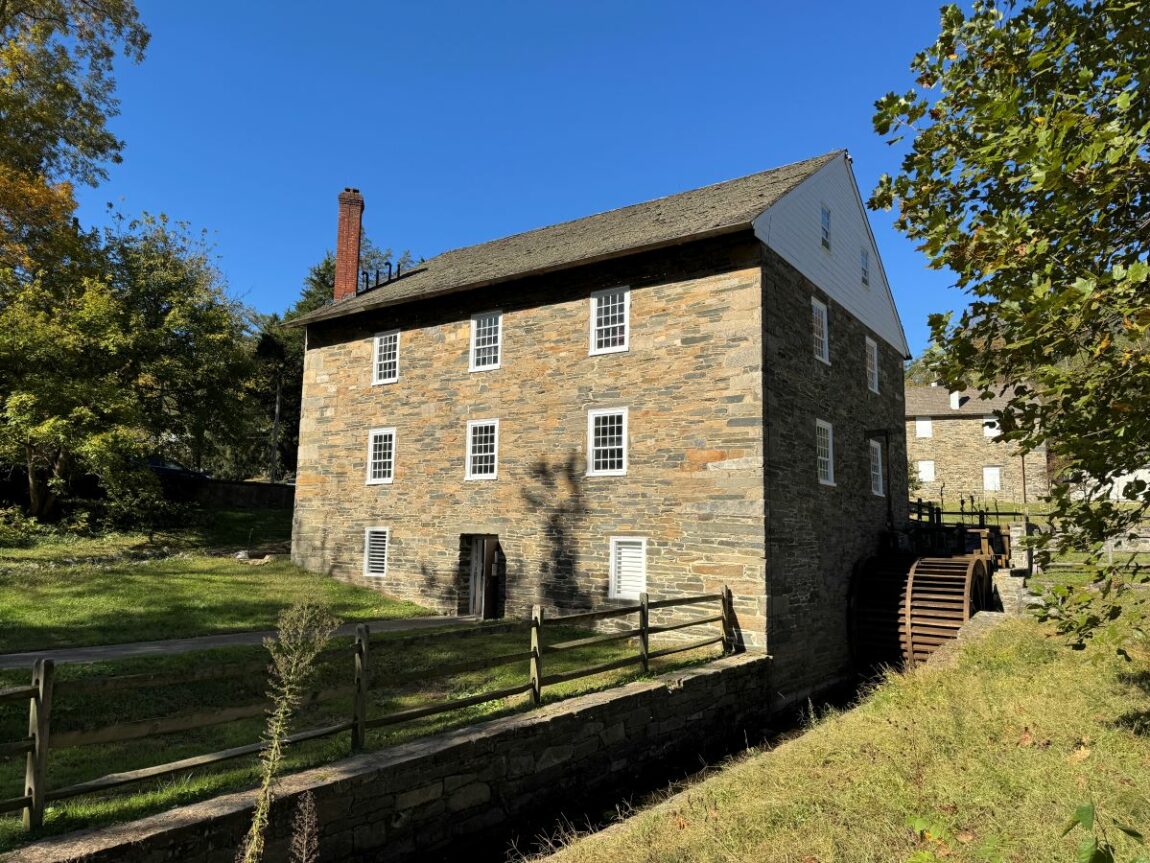
Explore the last operational grist mill in Rock Creek Park, Washington DC.
Built in Rock Creek in 1829, Peirce Mill ground corn, wheat, and rye using water as a power source. Constructed from blue granite, it features an Oliver Evans system that enables continuous operation and simplifies labor. Peirce Mill was designed as an investment to enhance returns for its lessees and boost production.
At one point, Rock Creek hosted several flour, saw, and other industry mills, powered by the creek’s waters, which dropped over 160 feet across 33 miles. Raw materials were supplied by local farms, and wagon paths facilitated transportation to the mills.
Spelling of Peirce
The spelling of the last name “Peirce” was not standardized. Early census records show it spelled as “Peirce,” while other records indicate variations like “Pierce” and “Pearce.” However, the majority of records use the “Peirce” spelling, which is the version the National Park Service has chosen to adopt.
Operating Hours
- April through October: Friday-Sunday, 10 AM to 4 PM
- November and December: Weekends, 10 AM to 4 PM
- January and February: Weekends, 12 PM to 4 PM
- March: Weekends, 10 AM to 4 PM
Information panels outside the property provide insights into the mill’s history. Plan to visit for around 20 minutes.
The National Park Service conducts mill operation demonstrations on the 2nd and 4th Saturday of each month from April through October.

Peirce Mill. Rock Creek Park, Washington DC. Credit: Carry on Caro
Featured tours
The History of Peirce Mill
Peirce Mill operated as both a merchant and custom mill, grinding corn, wheat, and rye. With just two or three men, the mill could process an estimated 150 bushels of grain per day. Records from 1870 indicate that Peirce Mill produced 40 bushels of wheat flour, 150 barrels of rye flour, and ground 4,075 bushels of corn for animal feed destined for market.
Fast forward to the 20th century: the mill operated through World War II, providing meals to government kitchens, but it was never a significant money-maker. It ran sporadically until 1958, when operations ceased completely due to machinery issues, difficulty in finding trained millwrights, and fluctuating water levels in Rock Creek.
In 1967, there was renewed interest in restarting the mill, and by 1970, it was once again grinding corn under the supervision of Robert Batte and later Brian Gregorie. However, tropical storms in the 1970s caused further damage to the equipment, and the mill operated sporadically until 1993, when a catastrophic failure of the main shaft brought operations to a halt once more.
Peirce Mill reopened as an operating mill in 2011, thanks to the efforts of a nonprofit group called “The Friends of Peirce Mill.” This organization helped raise funds, secure grants, and assisted the National Park Service in restoring the mill to the point where it could once again grind corn.

Peirce Mill. Rock Creek Park, Washington DC. Credit: Carry on Caro
Despite restorations over time, Peirce Mill’s sturdy exterior and interior maintain the authentic appearance and atmosphere of a 19th-century gristmill, featuring the original 1820s stone walls, authentic wooden milling machinery, hand-hewn beams and columns, and heavy oak floorboards.
In 1967, there was renewed interest in restarting the mill and by 1970, the mill was once again grinding corn under the supervision of Robert Batte and later Brian Gregorie.
However, tropical storms in the 1970s caused further damage to the equipment, and the mill operated sporadically until 1993, when a catastrophic failure of the main shaft brought operations to a halt once more.
Peirce Mill reopened as an operating mill in 2011, thanks to the efforts of a nonprofit group called “The Friends of Peirce Mill.” This organization helped raise funds, secure grants, and assisted the National Park Service in restoring the mill to the point where it could once again grind corn.
Despite restorations over time, Peirce Mill’s sturdy exterior and interior maintain the authentic appearance and atmosphere of a 19th-century gristmill. It features the original 1820s stone walls, authentic wooden milling machinery, hand-hewn beams and columns, and heavy oak floorboards.
Peirce Barn
Close to the mill, there is a barn that serves as the visitor center, where you can find information about Rock Creek Park and a gift shop. Restrooms are available in the back.
Location
2401 Tilden St NW, Washington, DC.
The closest metro stations are Cleveland Park and Van Ness-UDC, which are a 30-minute walk downhill to the mill. The mill is also accessible via the Western Ridge Trail.
Parking lots are located across Tilden Street at Picnic Grove #1 and north of the mill off Beach Drive. Peirce Mill has its own parking available, and there is also some street parking nearby.
We are part of several affiliate programs including Amazon and Viator which means that we will earn a small commission at no extra cost to you if you make a purchase through the links included in this post.
